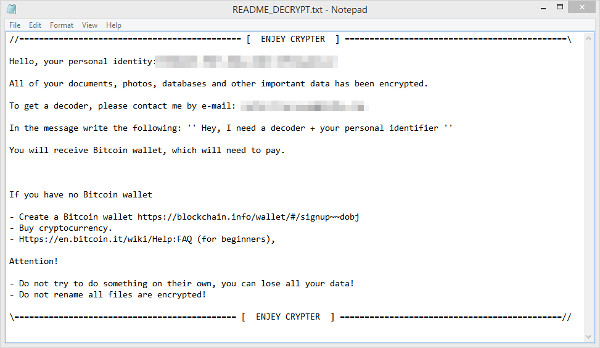RANSOM_EDA2ENJEY.A
Ransom:Win32/FileCryptor (Microsoft); MSIL/Filecoder.AK!tr (Fortinet); TR/FileCoder.pasdd (Antivir)
Windows


Threat Type: Trojan
Destructiveness: No
Encrypted:
In the wild: Yes
OVERVIEW
Downloaded from the Internet, Dropped by other malware
This Trojan arrives on a system as a file dropped by other malware or as a file downloaded unknowingly by users when visiting malicious sites.
It executes then deletes itself afterward.
It is capable of encrypting files in the affected system.
TECHNICAL DETAILS
13,312 bytes
, EXE
No
07 Mar 2017
Encrypts files
Arrival Details
This Trojan arrives on a system as a file dropped by other malware or as a file downloaded unknowingly by users when visiting malicious sites.
Installation
This Trojan drops the following files:
- C:\ProgramData\id.txt - contains username GUID
- {path of encrypted files}\README_DECRYPT.txt - ransom note
- {malware path}\~.bat - deletes malware and this batch file
It executes then deletes itself afterward.
Other Details
This Trojan renames encrypted files using the following names:
- {original filename}.encrypted.contact_here_me@india.com.enjey
It does the following:
- It deletes shadow copies by executing the following command:
- vssadmin delete shadows /all /quiet
- It avoids encrypting files in the following folders:
- Program Files (x86)
- $Recycle.Bin
- Windows
- Boot
- System Volum Information
- It is capable of sending the following information to a URL:
- GUID
- Username
- It sends information to the following URL:
- http://{BLOCKED}wallet.ru/css/add_text.php?data={random characters}={GUID}={username}
- The ransom note contains the following message:

It is capable of encrypting files in the affected system.
SOLUTION
9.850
13.268.08
10 Mar 2017
13.269.00
11 Mar 2017
Step 1
Before doing any scans, Windows XP, Windows Vista, and Windows 7 users must disable System Restore to allow full scanning of their computers.
Step 2
Note that not all files, folders, and registry keys and entries are installed on your computer during this malware's/spyware's/grayware's execution. This may be due to incomplete installation or other operating system conditions. If you do not find the same files/folders/registry information, please proceed to the next step.
Step 3
Search and delete this file
- C:\ProgramData\id.txt
- {path of encrypted files}\README_DECRYPT.txt
- {malware path}\~.bat
Step 4
Scan your computer with your Trend Micro product to delete files detected as RANSOM_EDA2ENJEY.A. If the detected files have already been cleaned, deleted, or quarantined by your Trend Micro product, no further step is required. You may opt to simply delete the quarantined files. Please check this Knowledge Base page for more information.
Step 5
Restore encrypted files from backup.
Did this description help? Tell us how we did.

